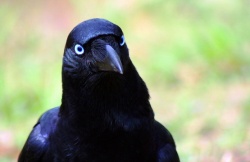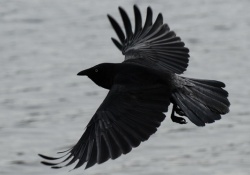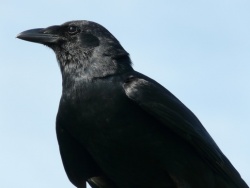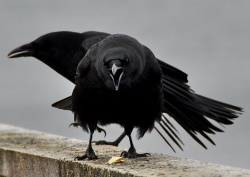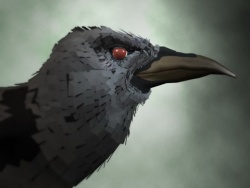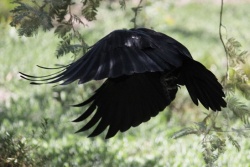Crow
Crows are members of a widely distributed genus of birds, Corvus, in the family Corvidae. Ranging in size from the relatively small pigeon-size jackdaws (Eurasian and Daurian) to the Common Raven of the Holarctic region and Thick-billed Raven of the highlands of Ethiopia, the 40 or so members of this genus occur on all temperate continents except for South America, and several islands. In Europe the word "crow" is used to refer to the Carrion Crow or the Hooded Crow, while in North America it is used for the American Crow or the Northwestern Crow.
The crow genus makes up a third of the species in the Corvidae family. Crows appear to have evolved in Asia from the corvid stock, which had evolved in Australia. The collective name for a group of crows is a flock or a murder.
Recent research has found some crow species capable of not only tool use but also tool construction and meta-tool use. Crows are now considered to be among the world's most intelligent animals with an encephalization quotient approaching that of some apes. The Jackdaw and the European Magpie have been found to have a nidopallium approximately the same relative size as the functionally equivalent neocortex in chimpanzees and humans, and significantly larger than is found in the gibbon
Description
Jungle Crow (Corvus macrorhynchos) scavenging on a dead shark at a beach in Kumamoto, Japan.
Corvus species are all black or black with little white or gray plumage. They are stout with strong bills and legs. The sexes are not very different in appearance.
Evolutionary history and systematics
Further information: Corvidae
Crows are believed to have evolved in central Asia and radiated out into North America, Africa, Europe, and Australia.
The latest evidenceregarding the crow's evolution indicates descent within the Australasian family Corvidae. However, the branch that would produce the modern groups such as jays, magpies and large predominantly black Corvus had left Australasia and were concentrated in Asia by the time the Corvus evolved. Corvus has since re-entered Australia (relatively recently) and produced five species with one recognized sub-species.
The genus was originally described by Linnaeus in his 18th-century work Systema Naturae. The name is derived from the Latin corvus meaning "raven".
The type species is the Common Raven (Corvus corax); others named in the same work include the Carrion Crow (C. corone), the Hooded Crow (C. cornix), the Rook (C. frugilegus), and the Jackdaw (C. monedula). The genus was originally broader, as the Magpie was designated C. pica before being moved later into a genus of its own. There are now considered to be at least 42 extant species in this genus, and at least 14 extinct species have been described.
There is not a good systematic approach to the genus at present. In general, it is assumed that the species from a geographical area are more closely related to each other than to other lineages, but this is not necessarily correct. For example, while the Carrion/Collared/House Crow complex is certainly closely related to each other, the situation is not at all clear regarding the Australian/Melanesian species. Furthermore, as many species are similar in appearance, determining actual range and characteristics can be very difficult, such as in Australia where the five (possibly six) species are almost identical in appearance.
Closeup of the upper body of a Jackdaw (Corvus monedula)
The fossil record of crows is rather dense in Europe, but the relationships among most prehistoric species are not clear.
Corvus brachyrhynchos call
Problems playing this file? See media help.
Crows make a wide variety of calls or vocalizations. Crows have also been observed to respond to calls of other species; this behavior is, it is presumed, learned because it varies regionally. Crows' vocalizations are complex and poorly understood. Some of the many vocalizations that crows make are a "Koww", usually echoed back and forth between birds; a series of "Kowws" in discrete units; a long caw followed by a series of short caws (usually made when a bird takes off from a perch); an echo-like "eh-aw" sound; and more. These vocalizations vary by species, and within each species they vary regionally. In many species, the pattern and number of the numerical vocalizations have been observed to change in response to events in the surroundings (i.e. arrival or departure of crows).
Intelligence
As a group, crows show remarkable examples of intelligence. Natural history books from the 18th century recount an often-repeated, but unproven anecdote of "counting crows" — specifically a crow whose ability to count to five (or four in some versions) is established through a logic trap set by a farmer. Crows and ravens often score very highly on intelligence tests. Certain species top the avian IQ scale. Wild hooded crows in Israel have learned to use bread crumbs for bait-fishing. Crows will engage in a kind of mid-air jousting, or air-"chicken" to establish pecking order. Crows have been found to engage in feats such as sports, tool use, the ability to hide and store food across seasons, episodic-like memory, and the ability to use individual experience in predicting the behavior of environmental conspecifics.
One species, the New Caledonian Crow, has also been intensively studied recently because of its ability to manufacture and use its own tools in the day-to-day search for food. These tools include "knives" cut from stiff leaves and stiff stalks of grass. Another skill involves dropping tough nuts into a trafficked street and waiting for a car to crush them open. On October 5, 2007, researchers from the University of Oxford, England, presented data acquired by mounting tiny video cameras on the tails of New Caledonian Crows. It turned out that they use a larger variety of tools than previously known, plucking, smoothing, and bending twigs and grass stems to procure a variety of foodstuffs. Crows in Queensland, Australia, have learned how to eat the toxic cane toad by flipping the cane toad on its back and violently stabbing the throat where the skin is thinner, allowing the crow to access the non-toxic innards; their long beaks ensure that all of the innards can be removed.
Crows have demonstrated the ability to distinguish individual humans by recognizing facial features.
Diet
Crows are omnivorous, and their diet is very diverse. They will eat almost anything, including other birds, fruits, nuts, mollusks, earthworms, seeds, frogs, eggs, nestlings, mice and carrion. The origin of placing scarecrows in grain fields resulted from the crow’s incessant damaging and scavenging, although crows assist farmers by eating insects otherwise attracted to their crops.
Life span and disease
Crows reach sexual maturity around the age of 3 years for females and 5 years for males. Some crows may live to the age of 20, and the oldest known American crow in the wild was almost 30 years old. The oldest captive crow documented died at age 59.
The American crow is highly susceptible to the recently introduced North American strain of West Nile virus. American crows typically die within one week of acquiring the disease and very few survive exposure.
Conservation status
The Hawaiian Crow or ʻalala (Corvus hawaiiensis) is nearly extinct; only a few dozen birds survive in captivity. The Hawaiian Crow is listed as "extinct in the wild" by the United States Fish and Wildlife Service.
Two species of crow have been listed as endangered by the U.S. Fish and Wildlife Service: The Hawaiian Crow and the Mariana Crow. The American Crow, despite having its population reduced by 45% since 1999 by the West Nile Virus, is considered a Species of Least Concern.
Hunting
The examples and perspective in this article may not represent a worldwide view of the subject. Please improve this article and discuss the issue on the talk page. (March 2013)
There is no bag limit when crows are taken during the "crow hunting season." According to the US Code of Federal Regulations, crows may be taken without a permit in certain circumstances. USFWS 50 CFR 21.43 (Depredation order for blackbirds, cowbirds, grackles, crows and magpies) states that a Federal permit is not required to control these birds "when found committing or about to commit depredations upon ornamental or shade trees, agricultural crops, livestock, or wildlife, or when concentrated in such numbers and manner as to constitute a health hazard or other nuisance," provided that
none of the birds killed or their parts are sold or offered for sale,
anyone exercising the privileges granted by this section shall permit any Federal or State game agent free and unrestricted access over the premises where the operations have been or are conducted and will provide them with whatever information required by the officer, and
nothing in the section authorizes the killing of such birds contrary to any State laws and that the person needs to possess whatever permit may be required by the State.
As a food supplement
Crows were hunted for survival by Curonians, a Baltic tribe, when common food was exhausted and the landscape changed so that farming was not as productive during the 18th and 19th centuries. Fishermen supplemented their diet by gathering coastal bird eggs and preserving crow meat by salting and smoking it. It became a traditional food for poor folk and is documented in a poem, The Seasons by K. Donelaitis. After the non-hunting policy was lifted by the Prussian government in 1721-1724 and alternative food supplies increased, the practice was forgotten. The tradition reemerged after World War I; it was common to find butchered crows in market places, which were sought after and bought by townsfolk. The hunted crows were not the local, but the migrating ones — each year during the spring and autumn crows migrated via the Curonian Spit between Finland and the rest of Europe. In 1943 the government even issued a hunting quota for such activities. Crows were usually caught by attracting them with smoked fish or grains soaked in spirit and catching them with nets. It was a job for the elderly or young who were unable to go to sea to fish, and it was common to catch 150 to 200 birds during a hunting day.
In human culture
Horow.jpg
The Common Raven and Carrion Crow have been blamed for killing weak lambs and are often seen eating freshly dead corpses probably killed by other means. The Australian raven has been documented chasing, attacking and seriously injuring lambs. Rooks have been blamed for eating grain in the UK and Brown-necked Raven for raiding date crops in desert countries.
In Auburn, New York, (USA), 25,000 to 50,000 American Crows (C. brachyrhynchos) have taken to roosting in the small city's large trees during winter since around 1993. In 2003, a controversial, organized crow hunt proved ineffective at reducing their numbers and the problem (concerns for public health and the sheer noise of so many crows) continues.
At a Technology Entertainment Design conference in March 2008, Joshua Klein presented the potential use of a vending machine for crows. He suggested the crows could be trained to pick up waste and the vending machine would be designed to give a reward in exchange for the trash.
Crows have been shown to have the ability to visually recognize individual humans, and to transmit information about "bad" humans by squawking.
Myth and spirituality
In Irish mythology, crows are associated with Morrigan, the goddess of war and death.
The god Bran the Blessed -whose name means 'crow' or 'raven'- is associated with corvids and death; tradition holds that Bran's severed head is buried under the Tower of London, facing France- a possible genesis for the practice of keeping ravens in the Tower, said to protect the fortunes of Britain. In Cornish folklore, crows -magpies particularly- are associated with death and the 'otherworld', and proscribes respectful greeting. The origin of 'counting crows' as augury is British; however, the British version rather is to 'count magpies' – their black and white pied colouring alluding to the realms of the living and dead.
In Norse mythology, Huginn and Muninn are a pair of ravens that range the entire world, Midgard, bringing the god Odin information.
In Sweden ravens are held to be the ghosts of murdered men. In Denmark the night raven is considered an exorcised spirit. There is a hole in its left wing where the stake used to exorcise it was driven into the earth. Anyone looking through the hole will become a night raven themselves.
In Australian Aboriginal mythology, Crow is a trickster, culture hero, and ancestral being. Legends relating to Crow have been observed in various Aboriginal language groups and cultures across Australia; these commonly include stories relating to Crow's role in the theft of fire, the origin of death, and the killing of Eagle's son.
The Chaldean myth the Epic of Gilgamesh, Utnapishtim releases a dove and raven to find land; however, the dove merely circles and returns. Only then does Utnapishtim send forth the raven, which does not return, and Utnapishtim concludes the raven has found land.
According to Ovid's Metamorphoses, in Greek mythology, the god Apollo became enraged when the crow exposed his lover Coronis' tryst with a mortal, his ire transmuting the crow's feathers from white to black.
In the Story of Bhusunda, a chapter of the Yoga Vasistha, a very old sage in the form of a crow, Bhusunda, recalls a succession of epochs in the earth's history, as described in Hindu cosmology. He survived several destructions, living on a wish-fulfilling tree on Mount Meru. Crows are also considered ancestors in Hindiusm and during Śrāddha the practice of offering food or pinda to crows is still in vogue.
Crows are mentioned often in Buddhism, especially Tibetan disciplines. The Dharmapala (protector of the Dharma) Mahakala is represented by a crow in one of his physical/earthly forms.
In Japanese mythology, a three-legged crow called Yatagarasu (八咫烏?, "eight-hand-crow") is depicted.
In Korean mythology, there is a three-legged crow known as Samjokgo (hangul: 삼족오; hanja: 三足烏).
In Chinese mythology, the world originally had ten suns embodied as ten crows, which rose in the sky one at a time. When all ten decided to rise at once, the effect was devastating to crops, so the gods sent their greatest archer Houyi, who shot down nine crows and spared only one.
In Hinduism, crows are thought of carriers of information. They give omens to people regarding their situations. For example : When a crow crows in front of a person's house, he is expected to have special visitors that day. Also, in Hindu literature, crows have great memories which they use to give information.
House Crow
Ancient Greek authors tell how a jackdaw, being a social creature, may be caught with a dish of oil that it falls into while looking at its own reflection. The Roman poet Ovid saw them as a harbinger of rain (Amores 2,6, 34). In Greek legend, a princess Arne was bribed with gold by King Minos of Crete, and was punished for her avarice by being transformed into an equally avaricious jackdaw, who still seeks shiny things. In Aesop's Fables, the jackdaw embodies stupidity in one tale, by starving while waiting for figs on a fig tree to ripen, and vanity in another – the daw sought to become king of the birds with borrowed feathers, but was shamed when they fell off. Pliny notes how the Thessalians, Illyrians and Lemnians cherished jackdaws for destroying grasshoppers' eggs. The Veneti are fabled to have bribed the jackdaws to spare their crops. Another ancient Greek and Roman adage runs, "The swans will sing when the jackdaws are silent," meaning that educated or wise people will speak after the foolish become quiet. In reality, corvids are among the most intelligent birds in the world, and this traditional association with ignorance is quite inaccurate.

